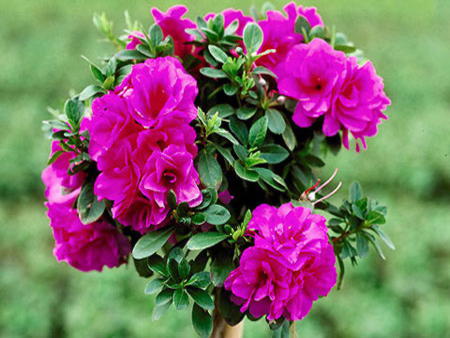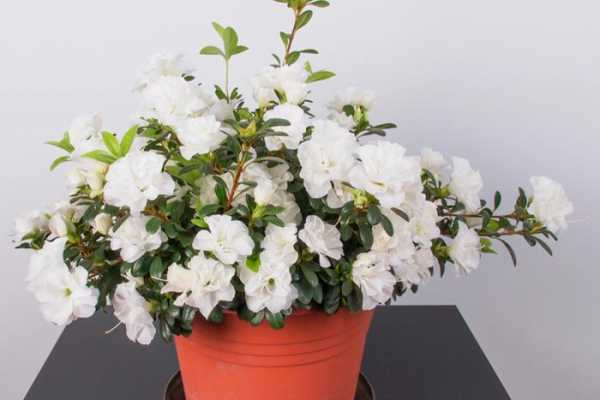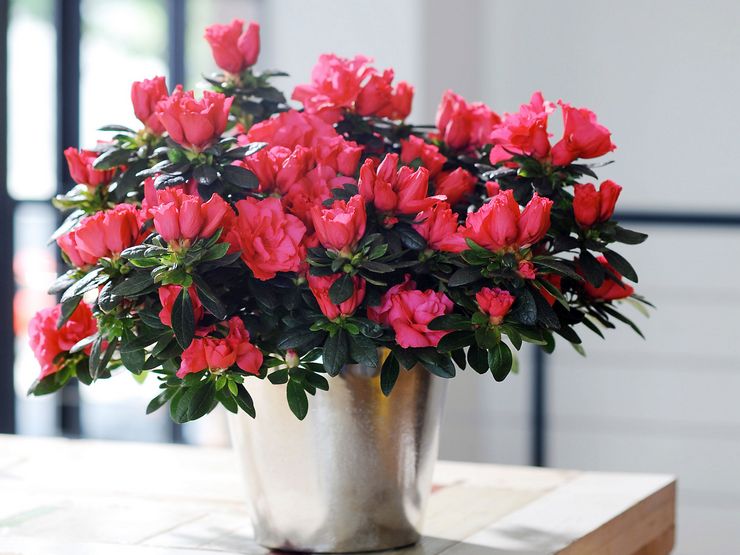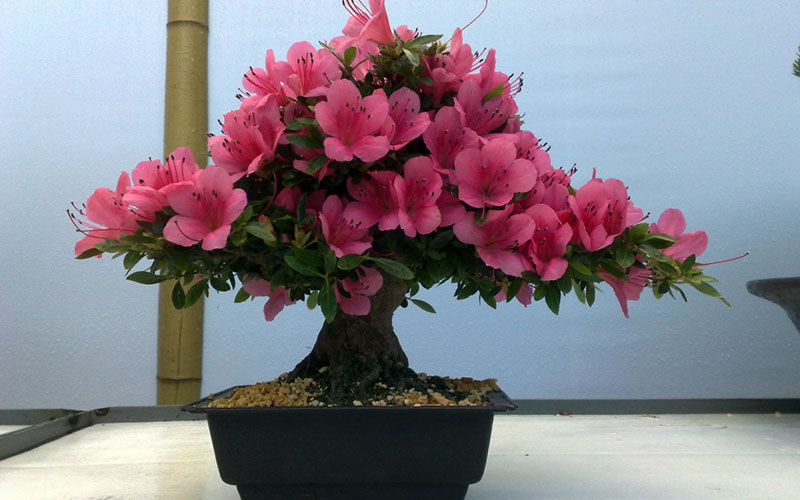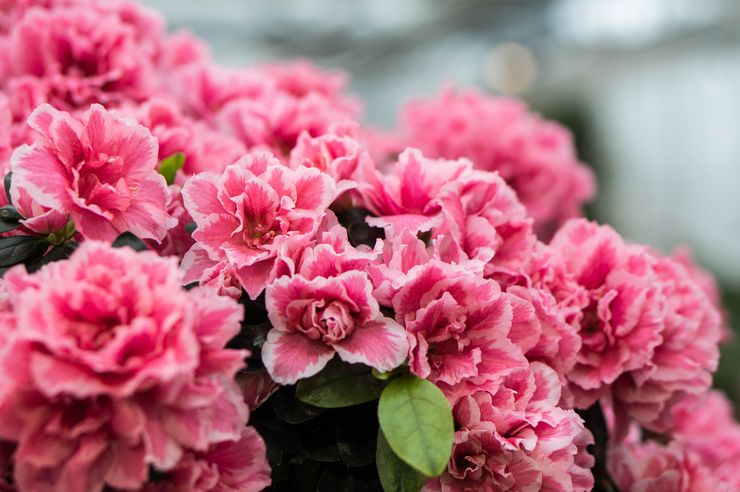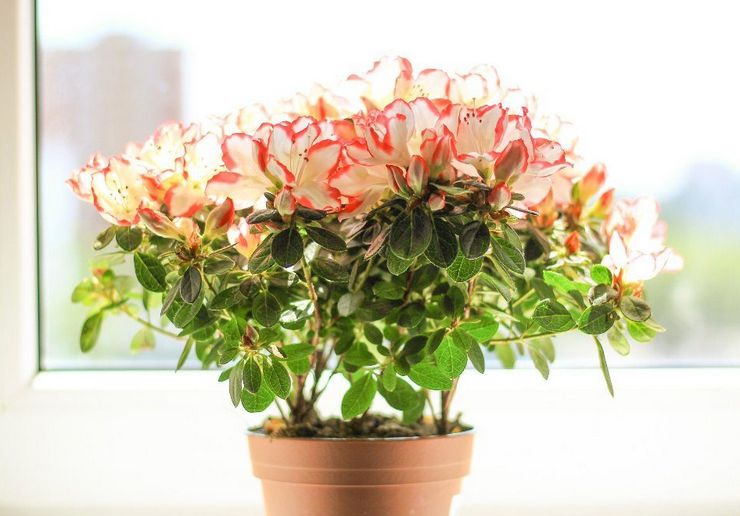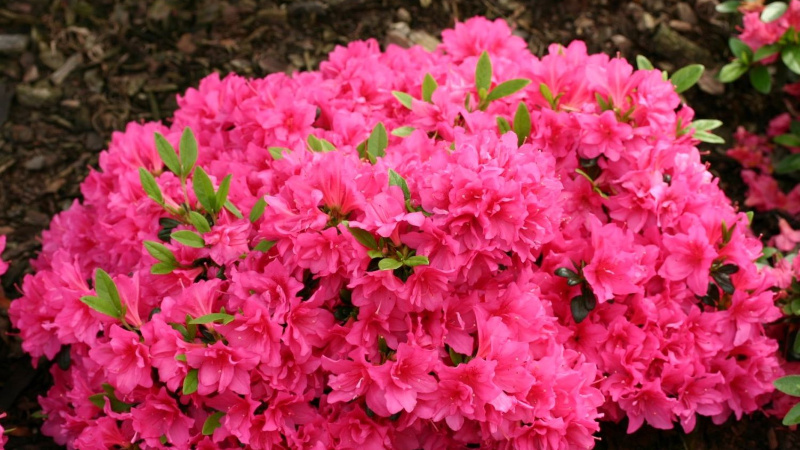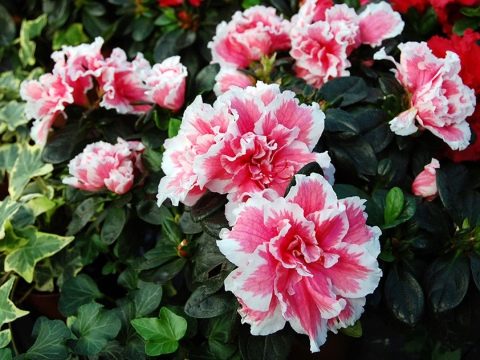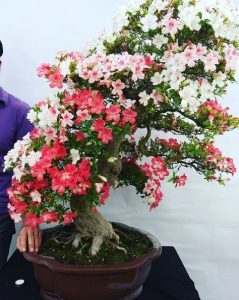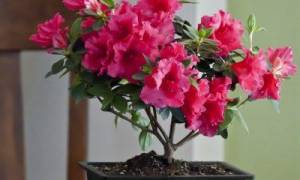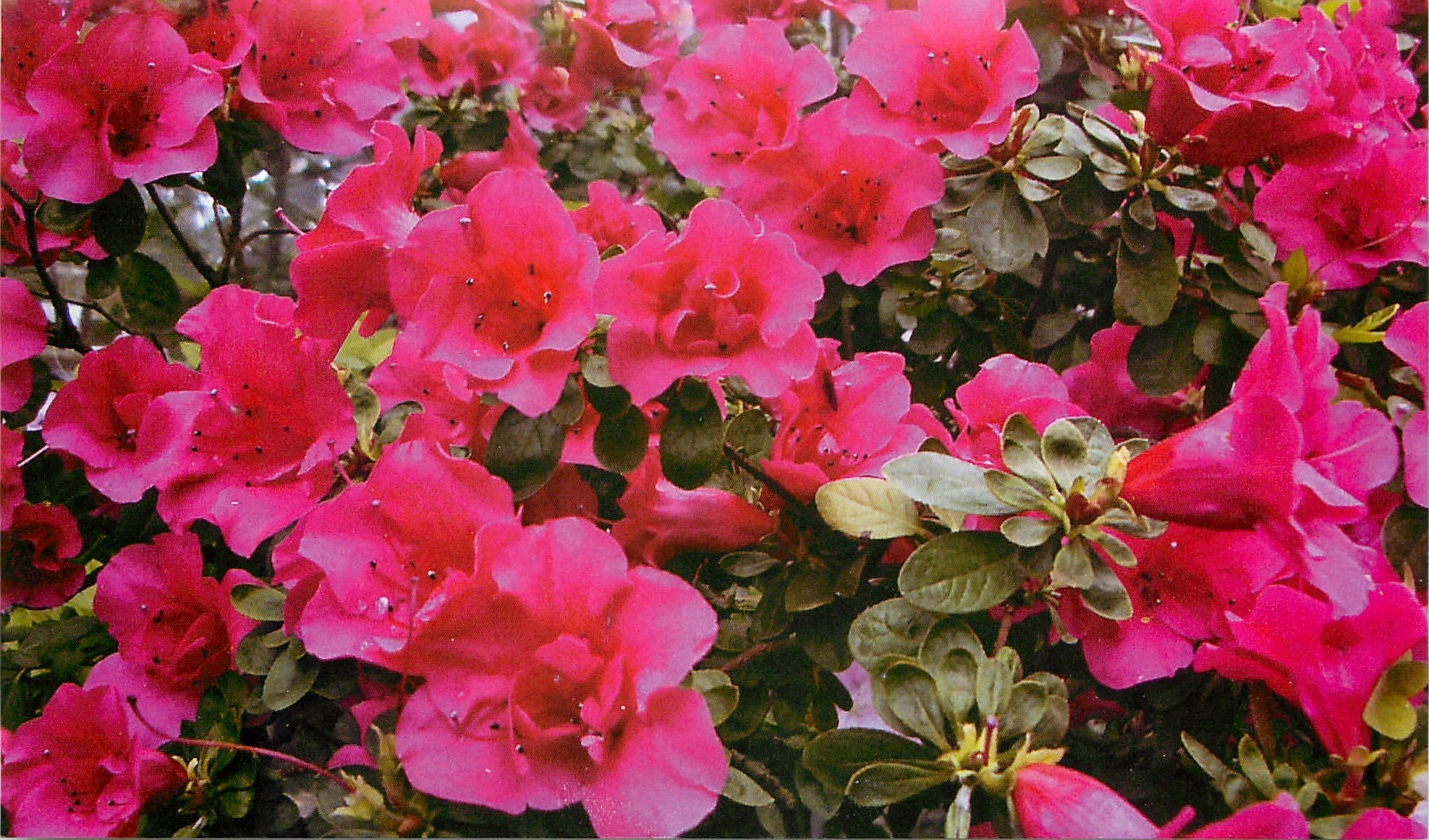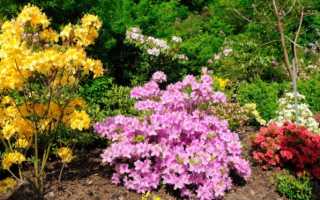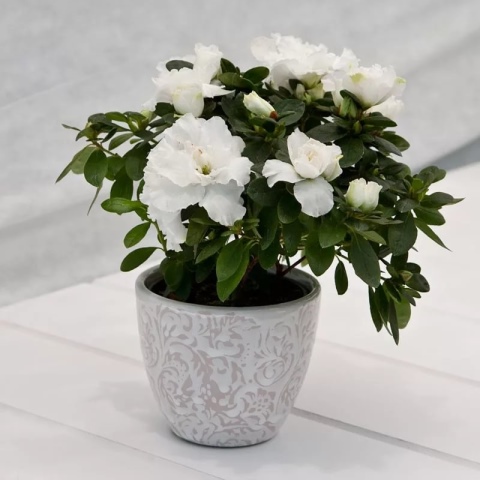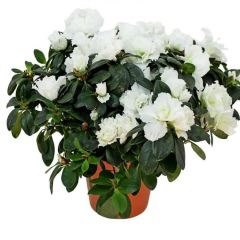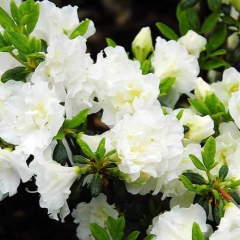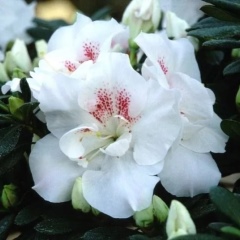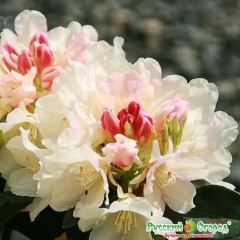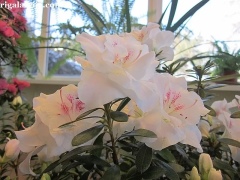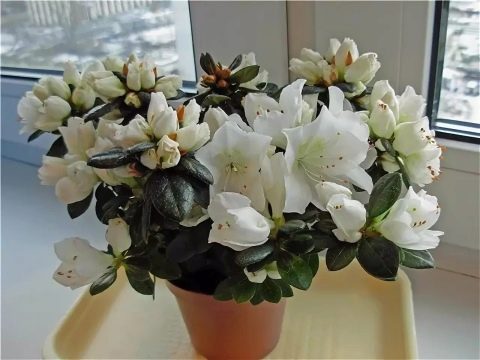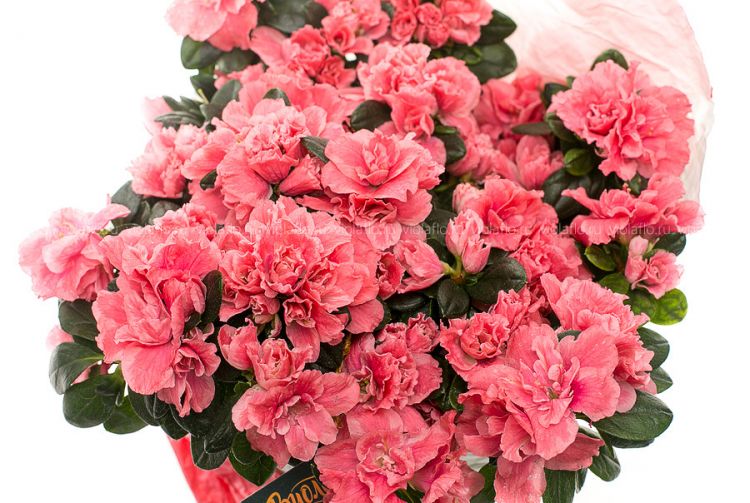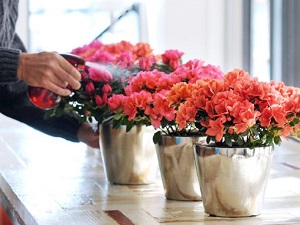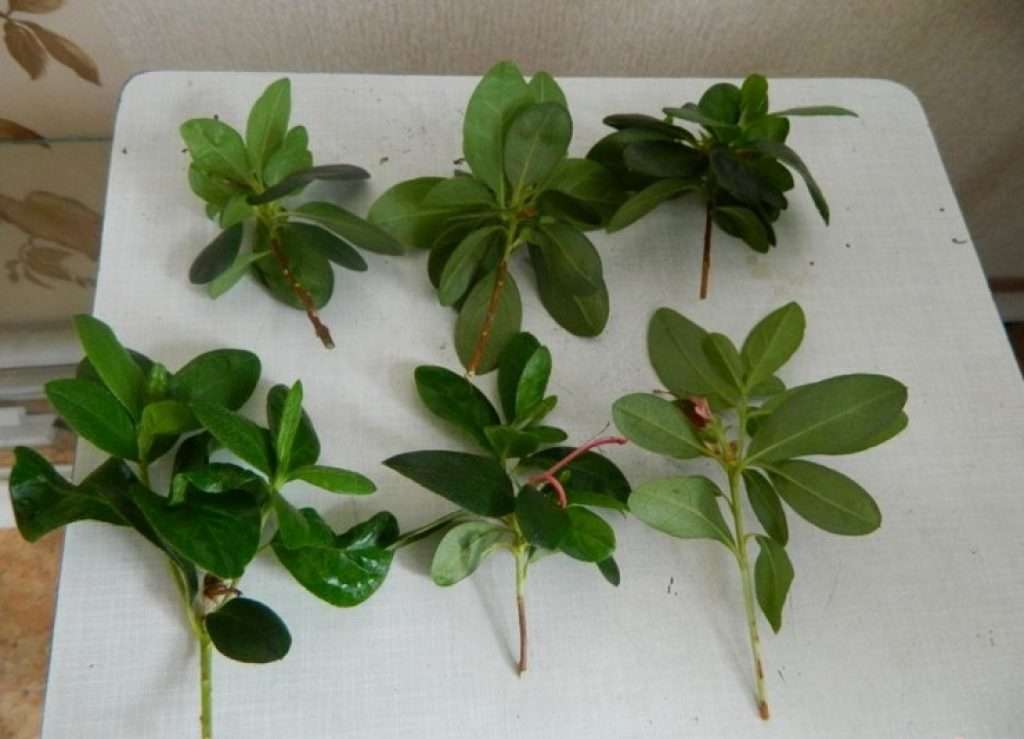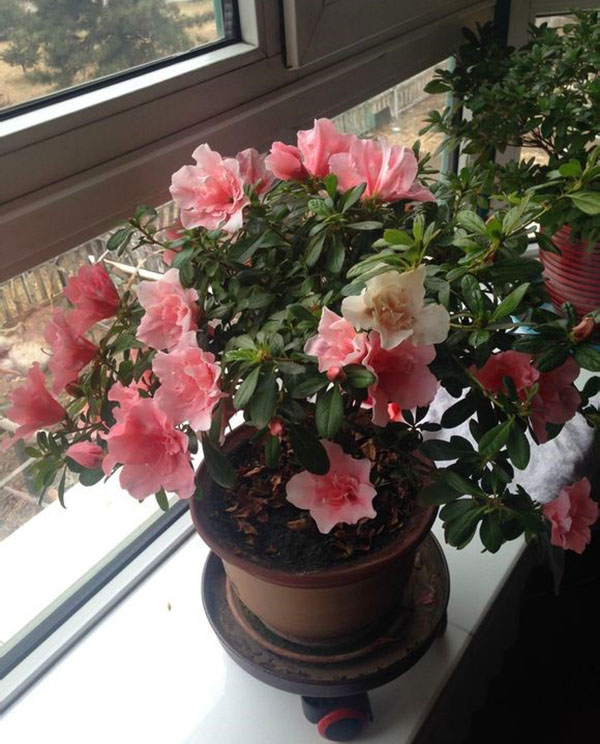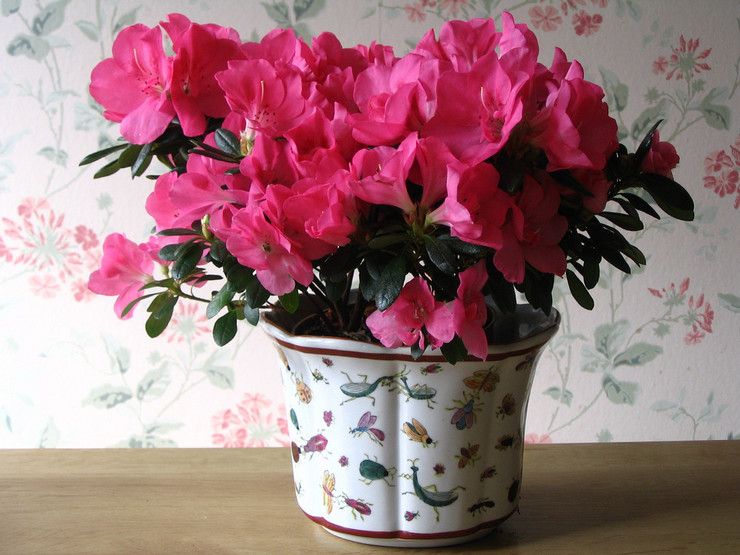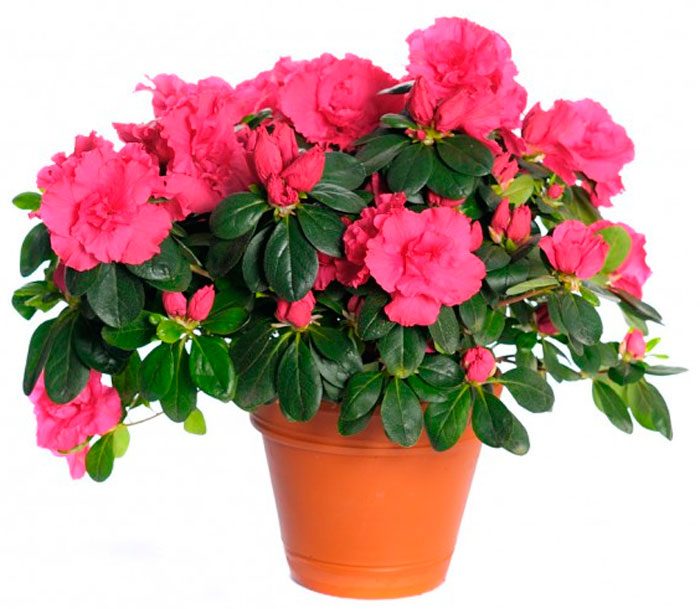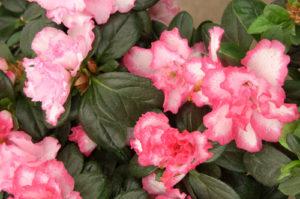Diseases
Shrubs planted in direct sunlight are more at risk of getting sick.
Also negatively affects the health of Azalea:
- increased soil moisture,
- lack of fertilizers,
- a sharp change in climate,
- attack of pest colonies.
Fusarium
The pathogen penetrates the root system and affects the vessels of the Azalea. This damage prevents the spread of nutrients. Shoots and leaves begin to wither and dry out. Then the foliage falls off. If you do not start treatment, the shrub dies.
You can get rid of fusarium with the help of Fundazol.
Phyllocytosis
It is a fungus that causes brown spots to form. The core of the spot begins to brighten, dry out, and then a hole forms in its place. The plant dies quickly.
The treatment consists of two stages. First, all affected shoots, leaves are removed and burned. Then carry out the treatment with "Fundazol" or "Topsin-M".
Cercospora
The external manifestation of the disease looks like brown spots, a red outline forms along the edge. They are especially visible from the inside of the sheet plate. A gray bloom appears on the leaves. Leaves in the lower part of the shrub are more often affected.
Treat cercosporiasis with fungicides "Ditan M-45" and "Fundazola"
Alternaria
Fungal infection. Bright red-brown spots appear on the leaves. The spots come in a variety of shapes and sizes. If the shoots are not cured, the spots merge into one large lesion and destroy the leaf plate.
You can get rid of the defeat with the help of 3% Bordeaux liquid and fungicides.
Rust
The causative agent is a fungus. The disease manifests itself in the autumn season. It starts from the inside of the sheet plate. The lesion looks like orange spots, with dark blotches, reminiscent of real rust.
All affected areas are cut and burned. If the disease is detected at an early stage, the shrub can be treated with Bordeaux liquid. In advanced cases, copper-containing preparations are used.
Gray rot
Fungal lesions are found in almost every corner of the planet. Prefers a humid climate. Has different forms and manifestations. Brown lesions appear on the shoots, which dry out the surface of the shoot, as a result, the damaged area begins to crack. When the humidity rises, the affected areas quickly become covered with a gray, fluffy bloom.
Affected shoots are cut off. The plant is treated with Fundazole solution.
Wax disease
The sheet plate becomes thicker, begins to deform. Sometimes it changes color to brown, becoming covered with spots. Less often, the green color of the plate is replaced by yellow. On evergreen shrubs, white pads appear in the form of outgrowths.
Bordeaux liquid is used as a prophylaxis for fungal infections. The affected areas are removed, and the shrubbery is treated with Cumulus.
Buying Indian Azalea
Indian azalea (Azalea indica) must be chosen carefully. It is better to take a flowering bush as a gift. For myself - a less decorative, but more promising plant, strewn with buds, and not flowers. It is better if there is at least one fully opened bud. It will confirm the desired coloration. Indian azalea pleases us with flowering in late autumn and winter, in the darkest time of the year
This is very important, since flowering plants are an effective means of fighting depression (more about this: "Houseplants blooming in autumn and winter as a remedy for depression")
For continuous flowering from autumn to spring, it is better to select azaleas that open flowers at different times.Early varieties - from December to January, mid-late - from January to March, late - from February to April. Varieties differ not only in terms of flowering, but also in color of flowers. They are one-color (white, cream, pale purple, red, etc.), two-color (pink with a white border around the edge of the petals; variegated, with a colored center, etc.). Flowers also differ in other features: the degree of terry, the presence of a fringe, etc. There are a lot of varieties and hybrids of Indian azalea, there are catalogs that allow you to find out about old varieties and new items.
When buying, you should pay attention to the condition of the bush. I am always alarmed by azaleas, which are difficult to find fault with: tall, with huge flowers and dark green leaves
Often, such plants, pumped up with all kinds of stimulants, "burn out" faster than those that look more modest and more natural. Inexpensive, very tiny bushes are often on sale. They are also less reliable than medium-sized azaleas. Of course, azaleas should not have dried buds, leaves and ... pests. Plants with overdried or waterlogged (slimy) potted soil are problematic.
Varieties - description and photo
Mix
Azalea Mix has small dark green leaves and large inflorescences of red, yellow, white, cream and pink. There is a heterogeneous color of flowers. The central shoot can reach a height of 50 cm. The plant is quite picky about care, which, nevertheless, does not stop gardeners from actively cultivating it.
For the Indian azalea mix, the composition of the soil is of paramount importance - when planting, an acidic soil with a high content of organic elements is used.
Bicolor (pink)
Azalea Bicolor is one of the brightest varieties of rhododendrons. The height of the plant can reach 0.5 m. The inflorescences of the Indian azalea are medium-sized and pink, and the leaves are dark green.
White
White Indian azalea is found in several varieties:
- apollo;
- sakulant;
- Weiss Sheme.
The inflorescences of the white azalea are quite large, they can reach 7 cm in diameter. The petals of the flowers are white and slightly light green at the base.
Red
The flowers of the red azalea are double-type and reach a diameter of about 6 - 6.5 cm, and the leaves are dark green. A bright red plant can be grown by planting Knut Erwen.
Flamenco
This azalea variety assumes the presence of double inflorescences that have a neat white-pink color. The duration of flowering is from the beginning of autumn to the end of April. The plant is distinguished by the abundance and brightness of flowers.
Simsa
Sims bloom in the winter-spring period. The color range of inflorescences is varied - from white to red. The size of the buds reaches 3-5 cm, the petals of the plant are bifurcated and have double or grooved edges.
Helmut
Indian azalea helmut differs from other types of azaleas in rather bright double inflorescences of purple-red color, the diameter of which can reach about 6 cm.
In our articles, you can learn about azalea species, including Bloumbux, as well as growing in the form of bonsai.
What conditions are required?
When planning to propagate this beautiful ornamental plant, it is important to pay attention to the quality of the planting material. It must be sourced from a healthy, mature and well-developed plant that is adapted to housekeeping. Too young and weak plants are not suitable for obtaining planting material, since they have a low donor potential
Very mature and old azaleas are also almost not used for the procedure, since at this age stage their metabolic processes slow down, nutrients, micro- and macroelements are less absorbed. Together, these factors make older plants unsuitable for reproduction.
Too young and weak plants are not suitable for obtaining planting material, since they have a low donor potential. Very mature and old azaleas are also almost not used for the procedure, since at this age stage their metabolic processes slow down, nutrients, micro- and macroelements are less absorbed. Taken together, these factors make older plants unsuitable for reproduction.
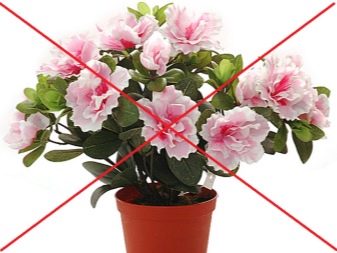
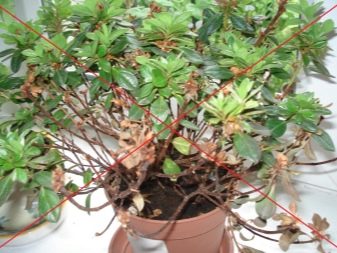
Another equally important condition on which the results of the upcoming event depend is the quality of the soil mixture. Its composition and properties are of equal importance both when breeding an azalea with seeds, and when propagating it by cuttings or dividing a bush.
If sand is used as part of the soil mixture, it must first be sieved, washed and calcined.
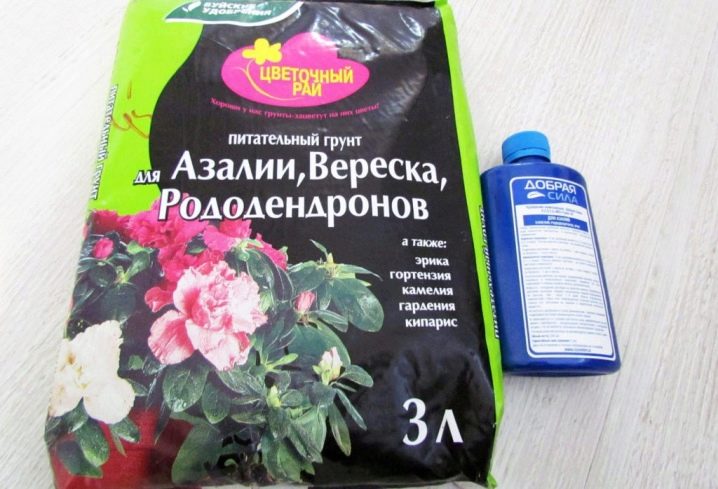
Other conditions that provide effective breeding of indoor azaleas are:
- creating a greenhouse effect;
- maintaining sufficient air humidity;
- ensuring a stable temperature regime.
The greenhouse effect is essential for seed germination and rooting of cuttings. It can be provided with the help of an impromptu greenhouse made of a plastic bottle cut in half, a container with a lid or plastic wrap, which is tightened with a container with planting material.

Considering that this ornamental culture is moisture-loving, it is important to ensure sufficient air humidity when breeding it. This can be done by periodic spraying and irrigation.
You can also maintain the required level of moisture in the air using a special room humidifier or a wide container filled with water and placed next to the plants.

Despite the fact that to date, breeders have managed to obtain cold-tolerant hybrids, when breeding azaleas, it is still desirable to maintain the temperature at 22-25 °.

Varieties: description and photo
Azalea varieties can be categorized by color:
- red;
- purple;
- white;
- pink;
- blue.
Red
Rhododendron "Sneezy"
Unusual variety. The flowers bloom scarlet and gradually, in a chaotic manner, first turn into a pink shade, and then into white.
Apollo
Tall bush. The flowers are brick-red with a diameter of 7.5-8.5 centimeters. Bloom from January to April.
Purple
"Marcel Menard"
Has flowers of a bright purple hue. There are brownish-orange spots on the petals.
We suggest watching a video about the azalea Marcel Menard:
"Elsie Lee"
Flowers of a pale purple shade with pink dots. Diameter of flowers: 8 - 9 cm. Leaves are light green, oblong. Height up to 80 centimeters.
Elsie Lee tolerates winter well.
We suggest watching a video about Elsie Lee's azalea:
White
Azalea with white flowers:
- Watercolor;
- Aline;
- Albert-Elizabeth;
- Mary;
- Niobe;
- Rose Belton;
- Shakuntala;
- Snowflake;
- Heidi;
- Schneg.
"Esprinzessin (Azalea japonica Eisprinzessin)"
Height: up to 30 centimeters. Bush diameter: up to 50 centimeters. Bloom: May-June. Flowers: white with a pinkish core.
Tall. Flowers: white. Diameter: 8-10 centimeters. Bloom: March to May.
Pink
"Pink Lights"
Stunted. Flowers: deep pink shade, the top petal is maroon. Crown diameter: up to 1 meter. Height: 140 - 150 centimeters. Flower diameter: 3.5-4 centimeters. The variety "Pink Lights" is frost-resistant.
"Advents-glocken"
Tall. Flower diameter: up to 8 centimeters. Flowers: bright pink with a raspberry tinge. Bloom: November to March.
"Albert Elizabeth"
Tall. Flowers: pale pink with salmon border. Flowers diameter: 8-11 centimeters. Bloom: December to April.
"Verveniana"
Medium-sized. Flowers: pink and with a white border around the edge. Flowers diameter: up to 8.5 centimeters. Bloom: November to April.
Joy Haerens
Tall, medium late and spreading bush.Flowers: bright pink, heavy, strongly double. Diameter: up to 10 centimeters. A wave goes along the edge of the petals. Bloom: February to April.
Read more about pink azaleas here.
Blue
Pure blue azalea varieties have not been bred. Mixed types happen. Occasionally there is a blue tint in purple azalea varieties.
There is also a variety with pure blue flowers: "Rhododendron Russatsky". And the rhododendron of the "Peter Alan" variety has flowers of a blue-lilac shade with black-brown spots on the petals.
Azaleas in bloom are a fascinating sight, and the variety of existing colors is simply amazing.
Care features
Azalea care is aimed at creating conditions as close as possible to the natural microclimate of plant growth in the wild.
- Lighting. It withers under the direct action of the sun. Prefers to hide in partial shade, grows well in diffused bright light. In the summer they are taken out into the street, providing shading from the sun. If possible, drip directly into the pot in the shade of trees and shrubs.
- Temperature. In summer it is content with room temperature. In winter, it requires lowering it to 12-14 ° C. Under proper conditions, it winters safely at 20-22 ° C.
- Watering. The substrate is not allowed to dry completely. Moisture stagnation is also not allowed. Sprinkle with spring, river, melt, rainwater. When using tap water, it is defended for two days. The best option is to freeze the water in the freezer and then thaw it. After watering, the soil is not loosened - the roots of the azalea are very tender!
- Humidity. Looks better in high humidity conditions. In summer, it can do without artificial increase in humidity. In winter, it is recommended to spray the air around the flower, hang wet towels on the radiators, and put bowls of water next to them.
- The soil. The land for azaleas is sour. The optimum acidity is 4-4.5 pH. You can look for soil for azaleas and rhododendrons. The soil is prepared independently from a mixture of peat and coniferous soil. Sand is added to loosen it.
- Transfer. Young bushes require annual handling, adults "live" in one pot for 2-3 years. During transshipment, they try not to disturb the earthen lump. It is carefully moved into a larger pot and filled with fresh soil. Because of the shallow root system, the azalea pot is chosen wide and low.
- Top dressing. Fertilizers are applied frequently - at 1 week intervals. Recommended remedies are superphosphate, potassium sulfite, ammonium sulfate. The bulk of dressings falls on the spring-summer season. In the autumn-winter season, during the budding period, it is recommended to add superphosphate at the rate of 15 grams. preparation in a bucket of water.
Helpful Tips! To maintain the acidity of the substrate, it is recommended to add a little citric acid (several crystals) per liter of water for irrigation. It is useful to periodically water the azalea by completely immersing the pot in a bowl of water for a couple of hours. The water should reach the top of the pot, but not get into it. Excess water is allowed to drain and the flower is returned to its original place.
Description and photos of insects, measures to combat them
If insects are found on azaleas in the ground, it is necessary to clarify the type of pest in order to choose the most effective means for its destruction.
Rhododendron bug
An adult is about 3.5 mm in size. She lays eggs, covering them with a dark brown resinous mass. The larvae feed on the sap of the plant, which causes yellowing and gradual deformation of the leaf. The treatment of the affected areas with Malathion, Decis helps to get rid of the pest.
Mealybug
A white waxy coating on any part of the plant indicates the presence of a pest. With a small size of the affected area, they can be treated with a sponge dipped in onion juice. In a severe form of the disease, the use of Actellik or Malathion is recommended in accordance with the instructions.
Weevil
The wilting of the azalea may be due to the appearance of root-damaging larvae in the soil. Watering with Bazurdin's solution helps to get rid of them. Spraying the green part of the bush contributes to the fight against adults, for which the leaves and buds become food.
Beater
The parasite feeds on young leaves, in which it makes holes. In severe lesions, only a mesh of veins remains from the leaf plate. Treatment should be started when the first signs appear, applying Diazinon to the affected bush.
Slug
The parasite prefers to destroy the tender young leaves of the plant. As a pest control, Mesurol is used in accordance with the instructions.
Thrips
The leaves, which the pest chose as food, begin to turn yellow, characteristic holes form on them. Weakened azalea slows down the growth rate, stops blooming. To get rid of insects, the plant is treated with Carbofox solution or 0.2% Malathion emulsion.
Moth
Caterpillars damage leaves by eating them and using the back to form a cocoon. Fumigation with sulfur or spraying with Rogor's solution helps to cope with the pest.
Fly
The appearance of light spots on the leaves requires checking the back for the presence of rhododendron fly larvae that feeds on plant sap. The pest is only sensitive to nicotine sulfate.
Aphid
Slower growth, cessation of flowering and leaf curling may be due to aphids eating azalea juice. In the absence of the necessary assistance in the form of spraying with Aktellik, Ambush or Fitoverm, the plant dies.
Mite
In rooms with dry air at the base of the leaves, a spider mite can settle, feeding on flowers and young shoots. The presence of a cobweb helps to detect it.
For small lesions, the plant is treated with a soapy solution, followed by applying a solution of garlic to the leaves. In case of massive damage, the use of Actellic acaricide is required.
Azalea: home care
Now let's figure out how to care for an azalea at home, because the beauty of the bush and the splendor of flowering depend on maintaining optimal humidity and temperature, timely watering and fertilizing.
Light and temperature for azaleas
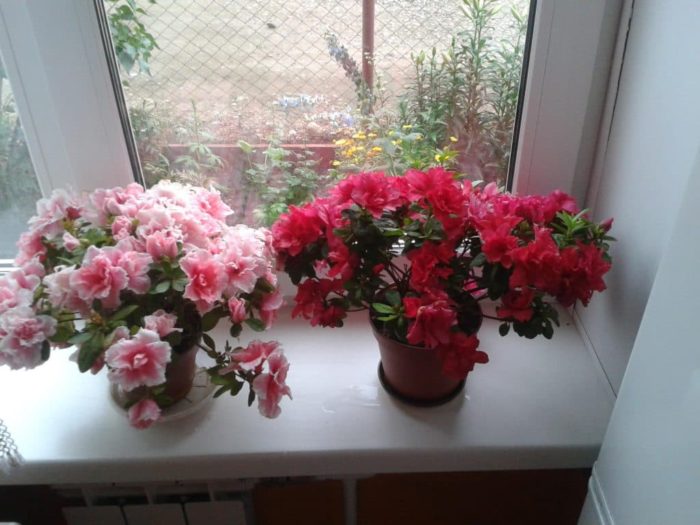
Caring for a room azalea begins with creating optimal humidity and maintaining a suitable temperature. The flower is light-loving enough, but does not tolerate direct sunlight, so the best place for a pot is on the east side of the house. Of course, you can put the plant on the windowsill of the western window, but then you need protection from the sun with curtains. On the northern windowsill, the azalea will feel good only if it is additionally illuminated with phytolamps
It is especially important to do this in October and November, when new buds are laid in the plant.
This variety of flowers is not considered to be thermophilic, therefore the optimum temperature is 15-18 ° C. During the formation of buds, it is lowered to 10-12 degrees. In summer, it is advisable to keep the room temperature below 20 ° C. In principle, the same conditions are created when caring for an azalea in a pot after purchase.
Humidity and watering
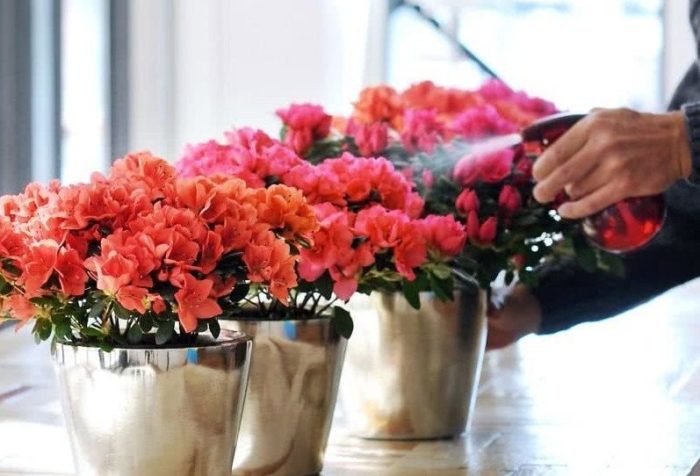
The bush needs a sufficient amount of moisture, so it is not only watered, but also sprayed. During flowering, instead of spraying, the pot is placed in a tray with wet expanded clay. In the summer, the azalea is allowed to be taken out into the garden, and during the heating season it is advised to use air humidifiers and place the container away from heating appliances.
Plant watering rules:
- during flowering, provide abundant watering - 2-3 times a week;
- the earthen coma should not be allowed to dry;
- after watering, the remaining water is drained from the pan;
- the soil is moistened with settled or melted water at room temperature;
- for a luxurious flowering, add a couple of drops of lemon juice to the water.
Azalea soil
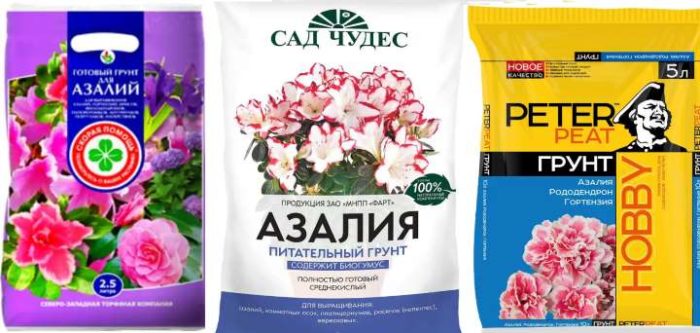
When describing how to care for an azalea in a pot, special attention is paid to the choice of soil. The plant needs acidic soil
The optimum acidity of the substrate is 3.5-5 pH. Ready-made land for azaleas is easy to buy in a specialized store.
In the case of self-preparation, adhere to the following proportion:
- coniferous forest land - 1 part;
- coarse river sand - the same amount;
- leafy soil - 1 share;
- peat - 1 part.
For planting azaleas, choose a small pot so that it does not waste energy on the growth of the root system. Otherwise, it will stop blooming. The material of the container does not matter. There must be drain holes at the bottom. Also, when planting, drainage from expanded clay or pieces of foam plastic 2 cm thick is first laid.
Pinching and pruning an azalea

To form a lush bush and abundant flowering, they are regularly cut and pinched. This is done at the end of the flowering period. Be sure to cut off all single flowers. In order for buds to form at the ends of new shoots, they are pinched. For pruning, a pruner is used, which shortens the elongated branches and shoots growing inside the bush. In two weeks, young leaves will appear on them. Pinching is carried out 2 or 3 times from April to July.
Fertilizers and feeding
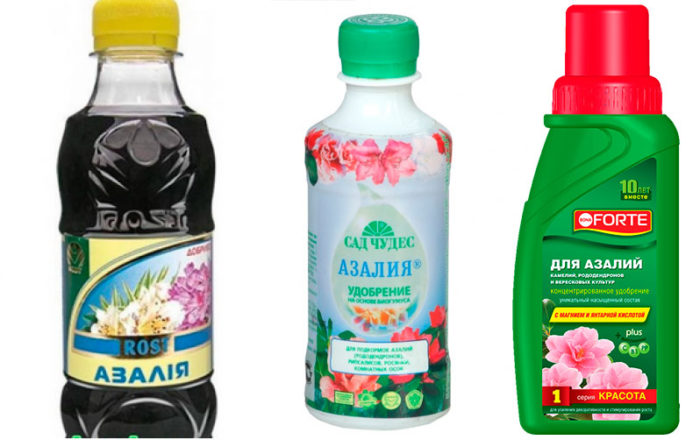
As a top dressing, chlorine-free mineral fertilizers for azaleas are used. They are sold in specialized stores. In summer and spring, nutrients are introduced into the soil once a week, and in winter - once a month. During the flowering period, mixtures with the content of phosphorus and potassium are used, therefore they buy the composition "Kemari-Lux" or "Uniflor-Bud".
5 pests and diseases
- When watering an azalea in a pot with hard water, the leaves may turn yellow.
- If the leaves turn brown and the plant dries up, the soil may be overdried.
- The buds can dry out when exposed to hot, dry air.
- Rhododendrons are susceptible to fungal diseases, such as powdery mildew, leaf spot, gray rot and late blight, root rot. The infected plant should be thrown away - it will not recover.
- Yellow leaves with green streaks are a sign of nutrient deficiency.
- Azalea leaves fall due to non-observance of the temperature regime or watering regime.
- Brown tips of the leaves may indicate the plant's bay. Such azaleas are removed from the pot along with a lump of earth and dried in the air for several days.
- Chlorosis that appears during watering with hard water can be cured by using iron preparations during watering.
- Azaleas become loose and elongated when grown in partial shade.
Bushes can attack spider mites. When grown outdoors, weevils and aphids can appear.
| Insect name | Signs of infection | Control measures |
| Weevil | Small denticles appear along the edges of the leaf plates, leaves and shoots of plants lose their turgor | Folk methods: transplant with a complete replacement of the substrate. The surface of the soil can be covered with plastic wrap for several days in order to prevent adult insects from entering to lay eggs. Adult insects are easy to pick up by hand at night. Spraying with hot pepper decoction. Chemicals: Bona Forte; Fitoverm; Actellik; Fufanon-Nova; Aktara; Kinmix. |
| Spider mite | Subtle spider webs on the leaves, yellowing and foliage falling off with extensive lesions. The surface of the sheet plates becomes dead and covered with small cracks. Plant development slows down. | Folk ways. Plants can be rinsed in the shower and left in the bathroom in a humid atmosphere for half an hour. Irradiation with an ultraviolet lamp every week for 2 minutes. Chemical preparations based on pyrethrum, sulfur powders, Fitoverm, Actellik. |
| Aphid | Sticky droplets appear on the leaf plates, the leaf plates curl and deform, delicate buds and young leaves wither.Insect colonies can be seen on the tops of the shoots, buds or the underside of the leaf plates. The flowers of aphid-infested plants may become deformed. | Folk methods: infusion of nettle, decoction of rhubarb leaves, wormwood, soap solution, infusion of tobacco and dandelion, onions, marigolds, yarrow, tansy, dusting with wood ash. Chemical preparations: Sulfur powders, green mass treatment with green potash soap without getting into the ground, Decis, Aktellik, Fitoverm. |
-
Aphid
-
Spider mite
-
Weevil
Azalea: home care
When growing rhododendron in indoor floriculture conditions, it is necessary to pay special attention to a number of requirements, which consist in the mandatory implementation of modern watering and feeding, as well as creating the most comfortable conditions for the plant.
Site selection and soil requirements
Rhododendrons are very fond of bright and diffused sunlight, therefore it is advisable to put a flower pot with a plant on southeast or south-western windows
It is imperative to avoid direct sunlight on the aerial area, especially foliage. In the summer, it is advisable to take out the culture to a shaded section of a balcony or loggia, which has a positive effect on winter flowering
The plant requires the organization of the correct temperature regime in the growing room. The average temperature should be approximately 15-18 ° C.
For planting and replanting, it is necessary to use not too deep and wide containers, at the bottom of which a drainage layer sufficient in height must be poured. You can use a ready-made special mixture for growing such a perennial, or make a nutritious soil substrate for planting yourself by mixing clean river sand with coniferous soil and peat soil.
How to water and feed an azalea
The roots of the rhododendron do not have root hairs, they are characterized as fibrous and rather shallow. Watering a decorative perennial should be as needed, using well-settled water at room temperature.
If the plant has withered due to too rare irrigation measures, then the indoor azalea can be “revived” with the help of a shower with a temperature of 28-30 ° C. A couple of times a month, you need to add a small amount of citric acid to the water for irrigation. Twice a week, the plant needs to be sprayed with warm and settled water from a household spray bottle.
Top dressing should be done with liquid complex fertilizers intended for growing indoor rhododendrons. It is necessary to add such a nutrient composition to the water for irrigation constantly, but in a small dosage. At the stage of active growth processes and in the phase of flower bud formation, organic fertilizers should be used for feeding.
Technology and timing of pruning room azalea
A very important role in the cultivation of rhododendron is played by correct and timely pruning, which must be done immediately after flowering. Withering buds must be removed immediately to extend the flowering period. After the flowering wave is over, each shoot needs to be pruned a few centimeters, and damaged or too weakened and elongated branches are removed completely.
Preventive actions
Plant parasites, represented by ticks, aphids, scale insects and mealybugs, can cause great harm to indoor flowering crops. For the destruction of striking parasites, it is advisable to apply treatment with special insecticides or a standard soap solution.
As a preventive measure, it is possible to recommend strict adherence to the full volume of the basic requirements for planting conditions, as well as the exclusion of stagnant water in the nutrient substrate and ensuring the air permeability of the flower soil.
What kind of flower?
Azalea (lat.Azalea).This is the name of a whole group of flowering plant species from the genus Rhododendron of the Heather family (Ericaceae). Earlier, these species were distinguished into an independent genus - Azalea.
Azalea or rhododendron (translated from Greek - "rosewood") is considered one of the most beautiful indoor plants. It is especially appreciated for the fact that, with its lush flowering, it brings the breath of spring in the midst of the winter cold.
A small strongly branching bush with small leaves in the winter months pleases the eye with a whole cap of amazing flowers.
Azalea flowers are double and simple, corrugated and fringed, all kinds of shades of pink, as well as white, red, purple and variegated. There are early and late flowering varieties.
Azalea is a very finicky capricious flower. But when in bloom - a real beauty. Warm regions grow it as a garden plant. The cold regions, on the contrary, domesticate it.
In natural conditions, it can be found in large territorial areas of Europe, North America and Asia. Japan considers the cultivation of this flower to be a whole cult. The flower became popular at the beginning of the 20th century. Grown in botanical gardens, various nurseries.
Nowadays, azalea is common among indoor plants, and is in great demand, because of its unusually beautiful flowering. But there are some serious details of care, and before you start this flower at home, you should familiarize yourself with these rules.
Caring for this flower is not an easy task. If you have just mastered the skills of a florist, then caring for an azalea will seem very laborious to you. You just need to know some rules for caring for azalea, for the best effect. The flower will delight you with lush flowering and longevity.




